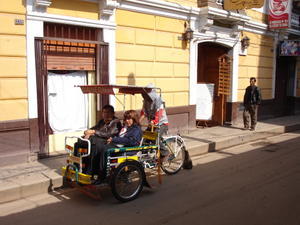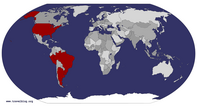Advertisement
Published: April 2nd 2007

 The Rickshaws of Puno
The Rickshaws of Puno
Most people get zipped around town in these bad boys. The rickshaw drivers sometimes think they are cars and honk at you if you cross the street in front of them Warning: this one is long and you may choose to skip my final rant about bad American tourists at the end!
Hello dear friends, how are you doing? I hope this entry finds you in good spirits and good health! Cuzco, Peru is the site of this entry, though the content will be about Puno, Peru, on Lago Titikaka. From your childhood history you may remember some random facts about this large lake in South America, a place that when I learned about it, I could hardly fathom because it was so far away and belonged to a culture so foreign, the Uros people. Here are some facts to jog your memory: Lake Titikaka is the highest navigable lake in the world, South America´s biggest lake and the largest lake in the world above 2000 meters (the lake sits at 3820 meters) and straddles the border between Peru and Bolivia. Let me now back up and speak a little about the ride from Arequipa to Puno.
The ride from Arequipa was quite amazing for a variety of reasons, all of them I will call "experiences." We departed late from Arequipa´s Terminal Terrestre around noon for a delightful

 Puno from Lago Titikaka
Puno from Lago Titikaka
Notice the green film on the water?five hour bus ride. If I have not mentioned this before, busses are the best way to get around Peru. Though slower and often including more "experiences" than planes they are extremely cheap and for the most part reliable. So, just before getting outside of Arequipa the Julsa (bus company name) bus pulled into a service station to fill up with gas. This was the first "experience" of the ride. Not only did we get topped off but a number of men in Julsa company mechanic´s suits wheeled what we initialy thought was an extra wheel up to the bus and, with much difficulty, crammed the thing in to the luggage storage space below the bus. Later, as we pulled off the road to support a downed bus we realized that what we intially though was a wheel was actually a diesel engine for the other bus. As I looked out on the barren plain I hoped that the other bus had a mechanic, or that the driver could fix the thing. We certainly did not bring a mechanic, nor did we bring any tools to help the repair job.
The second "experience" is in reference to how tightly

 A Small Uros Girl
A Small Uros Girl
Pretty cute and vibrantpacked and crappy the ride was in the back seat of a Julsa bus. Not only is there an extra seat in the middle at the end of the aisle but there is no arm rest in between anyone so I was constaly folding my shoulders in to prevent them from taking up too much space on either side. Additionally, the seats do not fold down so I slept like a bobble head doll, drooling on my chest. Plus, there is even less space between the back row and the second to last row. Unfortunately, to my delight the gent in front of me kept impulsively moving his seat up then down then up than down, each time slamming my knees.
The third "experience" was a sermon we recieved about spiritual, mental and physical health from a man claiming to be an "agent of the bus company" who I fondly think of as an agent of the devil. All I know is that he had some name tag around his neck, that´s all. He stood in the middle of the aisle of the bus yelling his sermon and pausing, evidently, to ask questions to which he never recieved an
answer. My only solace was the fact that I understand such little Spanish and he was speaking so quickly, that I could understand pretty much nothing besides "amigos" and "señors" that he used alternately to start every sentence. I was closer to being everyone elses amigo by attempting to quiet him, or holding my breath untill I passed out, whichever seemed easier. But in the end (an hour and a half later) and true to form, he tried to sell us some magical powder that could cure our moral, spiritual, physical and mental deficiencies. I could only laugh.
The last "experience" was the glorious beauty that surrounded us as we climbed from Arequipa to the high altiplano in which sits Lake Titikaka. Outside of Arequipa the bus followed the highway as it went all the way around the back sides of Chachani and Misti. As we rose, the land changed more and more into a tundra like expanse with low shrubs and large treeless mountains all around. About two hours into the ride we topped a hill and emerged into a large, fertile plain and passed a sign that read "Plain de Vicuna." As I peered out the windows

 Reed Boat
Reed Boat
Notice the Puma head?I caught glimpses of large packs of Vicunas (Alpaca like animals) feeding all across the plain with thier orange wool and white, shaggy underbellies waving in the wind. The highway was amazing, following a path that crossed fourteen thousand foot passes with snow all around and hail pelting the bus only to emerge by descended into small, lush, wet, green valleys littered with springs and Vicunas and Alpacas. From there, the land turned into the Scottish highlands with rugged rock outcroppings, green, green grass and miles of low stone fence criss-crossing the altiplano.
The next day´s highlight was a trip to the floating reed islands of the Uros people on Lake Titikaka. Though trying to use guided tours as little as possible, the use of aguide was necessary, unfortunately, for a worthwhile trip. The port of Puno was quite unattractive owing mostly to an inner harbor protected from the circulation of the lake´s waters that ensure the lake´s health and sustainability. In the pond and the inner Puno harbor the effects of Puno´s pollution were evident in the green algal slime that formed a thick, trash catching layer where even seagulls dared not go. Still, the twenty minute trip
out to the floating reed islands of the Uros was beautiful. Outside of the harbor the lake´s waters shimmerd in the high altiplano sun and mountains rose aroud her, accentuating the vast crater she occupied. We stopped briefly at a ship-turned-museum called the Yavari. The Yavari is an iron hulled ship built in England in 1862 and shipped/trained/hauled by mule over the Andes in 1383 pieces.
As we passed into the island complex of the Uros one of the boat´s mates paid the requisite two soles (about sixty cents) entrance fee. Later as we sat listening to the guide tell us about the history of the lake and the Uros people he stated that since we were learning about the Uros people in thier own words (translated by him) and in their own environment, we should support them by buying some of their crafts. Immediately the "you are a terrible hypocrite" bell rang inside my head. Each of the people on the tour paid at least twenty soles to view the islands and the boats heald nearly twenty tourists. So why don´t you give them more money to enter? Why don´t you give them money to help run their school and support them in a world which seaks to destroy ways of life like theirs. Instead you exploit them for the thousands of tourist dollars you make each year. And when it is all over you will move on to the next thing to exploit.
Still, the islands were quite amazing. The Uros people initially created and inhabited the islands as a refuge to escape from the expansionist Inkas centuries ago. To make the islands the men dive and cut five by five meter sections of reed root systems from the bottom of the lake. Once they have enough pieces they tie them together and anchor them to the bottom of the lake with huge, long stakes. Next, many layers of reeds are laid on top to make a spongy layer of that when you walk leaves you feeling like you are perpetually drunk. The water continually soaks into the reeds and the people pile fresh layers on every two weeks and eventually, over a period of ten years, the island becomes so waterlogged that it begins to sink, thus the Uros have been building new islands continuously for about 500 years. The reeds are used for everything: making rope, homes, beds, boats, the islands and even for food. On the fronts of their boats are woven Puma heads. In fact, that is where the lake received its name. The word titi means water and kaka means puma. Thus, the translation of the lake is roughly "water of the Pumas." Unfortunately, the Pumas of the altiplano have long since been hunted to extinction by indigenous and modern peoples. The islands were amazing and the Uros were very friendly. All in all, it was a great trip to Puno. Okay, now the rant...
I hate pre arranged tours because you undoubtedly get poor tourists like this along for the ride. As we motored away from the islands back towards Puno I was admiring the scenery when an American couple began to talk about Puno. The man, who was obviously well traveled, remarked that Puno seemed to be a "vibrant" place. The wife quickly retorted saying, in effect, that she thought Puno was ugly and dull, nothing like her beautiful and truly vibrant Chico, California where "tree lined streets" made it a wonderfully pleasent place to live. Last time I checked Chico was not a natural arbor haven, but a desert and the only way to make trees grow in a desert is to uselessly use obscene amounts of water. So, she chose to charcterize a culture and a way of life she percieved (that her husband rightly called vibrant) to be substandered to her own as "ugly" and "run-down." Well good, go back to Chico and tell your friends that Puno is the way you percieve it and tell them not to go. That way when I tell my friends that Puno is a town with delicious food, a huge market, a thriving trade industry and a wonderful example of the altiplano´s beauty, and a good example of how Peru uses, exploits, poisons and fluctuates within an environment (just like Chico does, only Puno has less money to make it beautiful) my friends will not have to listen to your firends talking about how crappy it is.
There I said it. But, to end on a high note, I love and miss you all.
Peace, Heart, Simon
Advertisement
Tot: 0.075s; Tpl: 0.012s; cc: 7; qc: 49; dbt: 0.0472s; 1; m:domysql w:travelblog (10.17.0.13); sld: 1;
; mem: 1.1mb









cam2yogi
Cameron Karsten
Perfect rant for the perfect world and its perfect diversity of people. I hope she does tell her friends so we can enjoy it as is - the good, the bad, and the ugliest make it what it is! Thanks, brotha-man